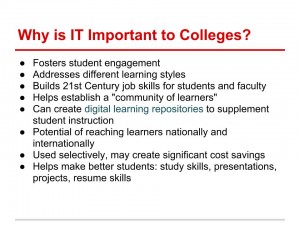A significant study was published in May 2012 by Ithaca S + R which bills itself as a “strategic consulting and research service . . . dedicated to helping the academic community use digital technologies . . .” The study, entitled “Interactive Learning Online at Public Universities: Evidence from Randomized Trials,” (link to study) received major funding from the Bill and Melinda Gates Foundation, and represents a significant effort to use strict research protocols to measure the effectiveness of hybrid learning in a randomized trial.
Overview
The study was significant since it focused on six public universities (CUNY and SUNY were represented) with substantial student diversity. The hypothesis involved whether such institutions could use hybrid course delivery to reduce costs associated with introductory courses and provide greater scheduling flexibility in the process. The courses used an ILO (interactive online learning) system developed by Carnegie Mellon for an Introductory Statistics course. The ILO system, still in its early stages, is a “sustainable and customizable platform for online learning” and is part of Carnegie Mellon’s Open Learning Initiative (link here) that “provides open, high quality courses, continuous feedback and research to improve learning and transform higher education.”
CUNY Central has supported hybrid learning for several years via small faculty development grants to CUNY schools. Since students from two CUNY colleges participated in the study, it is quite relevant to the potential of hybrid/online in this institution. Moreover, the study points to the efficacy of this mode of teaching to reduce costs while improving learning outcomes.
Findings
The study found “no statistically significant differences in learning outcomes between students in the traditional and hybrid format sections.” This finding is not surprising to those of us who have followed the literature in this area. There is even a “No Significant Difference” website which documents many studies that have reached similar conclusions. Although there are many within the academic community that are still skeptical about hybrid/online, it is clear that any mode of teaching can be used successfully for teaching and learning.
The study also indicated that students, although they performed as well in the class, seemed to prefer a traditional teaching approach. This finding is contrary to the bulk of the published literature. I suspect that since students were randomly assigned to either a traditional or hybrid class, those who were assigned to the hybrid felt they were not provided a choice in the matter and were negatively influenced. In addition, hybrid/online works best with mature, self-motivated students. The passive education received in many NYC public schools does not prepare students for taking a more active role in their learning process. Lastly, even the ILO designers admitted that the interface was not “aesthetically pleasing” and the user experience would be greatly improved in subsequent versions of the course.
My Thoughts
All of these studies concerning hybrid/online are important to advance the field and reduce resistance to online. As the major trend in higher education in the past decade, online learning is a powerful force that has the potential to transform the academy and learning generally. I always find it ironic that professors who teach in a traditional class rarely have their pedagogy questioned or classroom learning measured. Of course that is changing, largely due to increasing demands for accountability. However, professors in the forefront of developing hybrid and online courses need to receive institutional support for their efforts and also be rewarded in the tenure and promotion process for such work.
There is no doubt that at some point in the future, cost-savings can be achieved in terms of space utilization and more productive use of teaching faculty. I don’t feel this is the primary justification for exploring hybrid/online, especially recognizing the fact that there are many upfront costs in developing and supporting such programs. It would be better to see hybrid/online as investments in learning that should pay off in the medium term—around 3-5 years. With that perspective, added resources can go into developing better learning methods and systems, faculty development, and additional staffing (e.g. instructional designers and managers).
The potential for interactive online learning systems is tremendous. It offers the possibility of customizable learning per student, relevant feedback to both students and instructors, additional remediation done remotely and without instructor intervention, and a creative and enjoyable learning experience for the student. Any professor, no matter how skilled, would not be able to address all of these aspects of learning. In essence, these learning systems can supplement existing instruction, and extend the reach and effectiveness of professors in virtually any field.
Sources:
Bowen, W., et al, (2012), “Interactive Learning Online at Public Universities: Evidence from Randomized Trials,” ITHAKA S+R , May, 22, 2012. Retrieved from:
Meyer, L, (2012), “Interactive Online Learning Produces Learning Outcomes on Par with Traditional Teaching Methods,” Campus Technology, July 23, 2012. Retrieved at:



